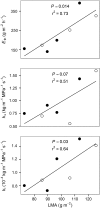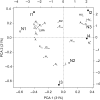Long-term impact of Ophiostoma novo-ulmi on leaf traits and transpiration of branches in the Dutch elm hybrid 'Dodoens'
- PMID: 26843210
- PMCID: PMC4885949
- DOI: 10.1093/treephys/tpv144
Long-term impact of Ophiostoma novo-ulmi on leaf traits and transpiration of branches in the Dutch elm hybrid 'Dodoens'
Abstract
To better understand the long-term impact of Ophiostoma novo-ulmi Brasier on leaf physiology in 'Dodoens', a Dutch elm disease-tolerant hybrid, measurements of leaf area, leaf dry mass, petiole anatomy, petiole hydraulic conductivity, leaf and branch water potential, and branch sap flow were performed 3 years following an initial artificial inoculation. Although fungal hyphae were detected in fully expanded leaves, neither anatomical nor morphological traits were affected, indicating that there was no impact from the fungal hyphae on the leaves during leaf expansion. In contrast, however, infected trees showed both a lower transpiration rate of branches and a lower sap flow density. The long-term persistence of fungal hyphae inside vessels decreased the xylem hydraulic conductivity, but stomatal regulation of transpiration appeared to be unaffected as the leaf water potential in both infected and non-infected trees was similarly driven by the transpirational demands. Regardless of the fungal infection, leaves with a higher leaf mass per area ratio tended to have a higher leaf area-specific conductivity. Smaller leaves had an increased number of conduits with smaller diameters and thicker cell walls. Such a pattern could increase tolerance towards hydraulic dysfunction. Measurements of water potential and theoretical xylem conductivity revealed that petiole anatomy could predict the maximal transpiration rate. Three years following fungal inoculation, phenotypic expressions for the majority of the examined traits revealed a constitutive nature for their possible role in Dutch elm disease tolerance of 'Dodoens' trees.
Keywords: Huber value; LMA; anatomy; petiole; potential transpiration; sap flow; water potential gradient.
© The Author 2016. Published by Oxford University Press. All rights reserved. For Permissions, please email: journals.permissions@oup.com.
Figures







Similar articles
-
Leaf trait dissimilarities between Dutch elm hybrids with a contrasting tolerance to Dutch elm disease.Ann Bot. 2013 Feb;111(2):215-27. doi: 10.1093/aob/mcs274. Epub 2012 Dec 21. Ann Bot. 2013. PMID: 23264236 Free PMC article.
-
Further insights into the components of resistance to Ophiostoma novo-ulmi in Ulmus minor: hydraulic conductance, stomatal sensitivity and bark dehydration.Tree Physiol. 2018 Feb 1;38(2):252-262. doi: 10.1093/treephys/tpx123. Tree Physiol. 2018. PMID: 29040781
-
Host responses and metabolic profiles of wood components in Dutch elm hybrids with a contrasting tolerance to Dutch elm disease.Ann Bot. 2014 Jul;114(1):47-59. doi: 10.1093/aob/mcu076. Epub 2014 May 22. Ann Bot. 2014. PMID: 24854167 Free PMC article.
-
Water relations in tree physiology: where to from here?Tree Physiol. 2017 Jan 31;37(1):18-32. doi: 10.1093/treephys/tpw102. Tree Physiol. 2017. PMID: 28173481 Review.
-
Entomopathogenic fungi as guardians of elm trees: A review of dual-action biocontrol agents targeting Scolytus spp. and their associated Ophiostoma species.J Invertebr Pathol. 2025 Jul;211:108361. doi: 10.1016/j.jip.2025.108361. Epub 2025 May 18. J Invertebr Pathol. 2025. PMID: 40393642 Review.
Cited by
-
Fungal canker pathogens trigger carbon starvation by inhibiting carbon metabolism in poplar stems.Sci Rep. 2019 Jul 12;9(1):10111. doi: 10.1038/s41598-019-46635-5. Sci Rep. 2019. PMID: 31300723 Free PMC article.
-
Blocking intruders: inducible physico-chemical barriers against plant vascular wilt pathogens.J Exp Bot. 2021 Feb 2;72(2):184-198. doi: 10.1093/jxb/eraa444. J Exp Bot. 2021. PMID: 32976552 Free PMC article.
-
Different Responses in Vascular Traits between Dutch Elm Hybrids with a Contrasting Tolerance to Dutch Elm Disease.J Fungi (Basel). 2022 Feb 22;8(3):215. doi: 10.3390/jof8030215. J Fungi (Basel). 2022. PMID: 35330217 Free PMC article.
References
-
- Allen RG, Pereira LS, Raes D, Smith M (1998) Crop evapotranspiration: guidelines for computing crop water requirements. FAO irrigation and drainage paper 56 FAO, Rome.
-
- Bauerle WL, Hinckley TM, Cermak J, Kucera J, Bible K (1999) The canopy water relations of old-growth Douglas-fir trees. Trees 13:211–217. doi:10.1007/s004680050235 - DOI
-
- Binz T, Canevascini G (1996) Xylanases from the Dutch elm disease pathogens Ophiostoma ulmi and Ophiostoma novo-ulmi. Physiol Mol Plant Pathol 49:159–175. doi:10.1006/pmpp.1996.0046 - DOI
-
- Brasier CM. (2000) Intercontinental spread and continuing evolution of the Dutch elm disease pathogens. In: Dunn CP. (ed) The elms: breeding, conservation and disease management. Kluwer Academic Publishers, Boston, pp 61–72.
-
- Bréda N, Huc R, Granier A, Dreyer E (2006) Temperate forest trees and stands under severe drought: a review of ecophysiological responses, adaptation processes and long-term consequences. Ann For Sci 63:625–644. doi:10.1051/forest:2006042 - DOI
Publication types
MeSH terms
Substances
LinkOut - more resources
Full Text Sources
Other Literature Sources
Miscellaneous

